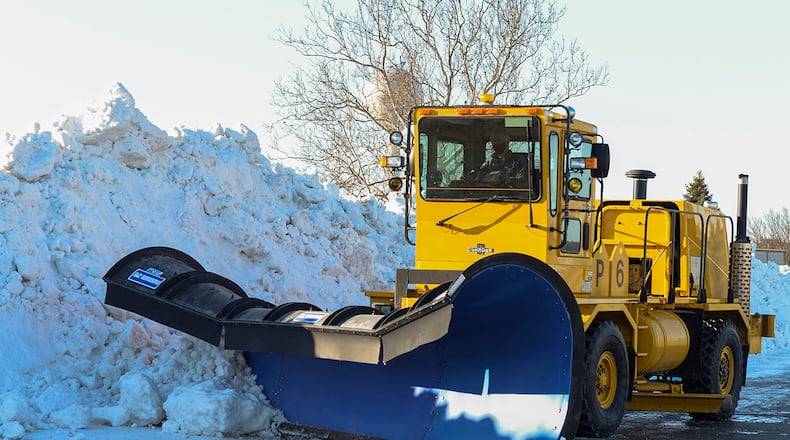February’s weather challenges proved no match for the equipment and ground-crews of the 88th Civil Engineer Squadron.
Two significant events that brought ice and snow to Wright-Patterson Air Force Base have been conquered with teamwork and positive attitudes, said Aime Haas, Area A ground supervisor and A-shift snow controller.
“The work that goes into clearing the snow is unreal,” said Travis Behnken, Area A equipment shop supervisor, “especially when you have small areas in which to put it.”
The crews have acquitted themselves well, said Scott Vincent, 88 CEG director, who provided a snapshot of what the 2020-21 winter season has brought to Wright-Patt:
- Usage of 1,700 tons of salt. The base’s five-year average is about 2,100 tons per season. “Winter is not over. We may meet that,” he said.
- 20 dump trucks bringing in a fresh delivery of salt last week to the base’s 1,000-ton capacity salt barn
- 8,829 hours devoted to clearing 120 miles of roadways, 984 football fields of parking lots and 331 miles of sidewalks
- 2,330 hours spent clearing the airfield’s 12,601 feet of primary runway, 7,000 feet of secondary runway and 937.5 football fields of pavement
“I’m really proud of what they’ve been doing,” Vincent said. “I’ve received compliments about their work. As Col. Patrick Miller, our wing commander, says, they’ve been ‘crushing’ it. I go out to talk to crew members as they are performing their operations, and they have great attitudes.”
He also highlighted how 88th Logistics Readiness Squadron mechanics and maintainers have contributed to the mission.
“They have been doing a stellar, amazing job in repairing the snow equipment,” he continued. “Some of our equipment is older and does break. The maintainers drop everything they are doing and fix our snow equipment right away when they don’t have to wait on parts. There have not been any large-scale breakdowns.”
The winter work hasn’t gone unnoticed across WPAFB, Haas said.
“We’ve had some nice kudos from base personnel,” she added. “They said they were amazed at what we accomplished in a short amount of time. The big picture is everybody is grateful for what we do, especially when they can park their car and get into their building.”
This week’s warming trend brought a welcome “breather” to the crews that have been working 12-hour shifts day after day, Behnken said.
“We’re all excited when the snow starts, then we get a bit tired day in and day out, working almost 13 hours per shift clearing snow, by the time you come in to get started or after your shift is essentially over,” Haas said. “But one thing about our crews – they take it all in stride. I’m extremely proud of how hard everybody in our shop works.
“We are also grateful to the augmentees who volunteer to assist us every year, as they are part of the snow team, too.”
Added Vincent: “Every single one of our team has been going out of their way to do a good job. They come in early, sometimes they stay late, and they make things happen.”
The CEG director also said ground-crews have closely followed COVID-19 safety protocols.
“When they exit a vehicle, they wipe it down to ready it for the next person so that person doesn’t have to worry about it,” he said. “We’re trying to minimize exposure. We’re not doing ‘warm’ handoffs to someone else. The equipment is parked while the steering wheel, controls and gear shifters are sanitized.”
Also, crews don’t congregate, and breaks are taken individually so the operators can maintain the posture and proper working conditions, Vincent said.
“Our snow team has not been immune to the pandemic,” said Harold Honeycutt III, supervisor of pavements, equipment and grounds. “During all snow events this season we have had to readjust our normal operations as we have had personnel on quarantine. All quarantined personnel have contracted the virus out of the shop, but any time you lose a valued member of your team, it hampers your ability to respond to the situation.”
Behnken said he is already thinking of snow-removal needs for the next winter season.
“You see what works and what doesn’t,” he said.
With February almost over, thoughts of March and spring aren’t far behind. Haas said crews will begin their work readying mowing equipment soon.
“You get one season over with, and then you typically begin thinking of what could happen the next time it rolls around,” she added. “It’s nonstop. You’re always trying to anticipate.”
88 CEG is runner-up for Mayes Award
In what is welcome news during Engineers Week (Feb. 21-27), founded by the National Society of Professional Engineers, the 88 CEG team was named runner-up for the Brig. Gen. Archie S. Mayes Award.
The award recognizes the top Air Force Civil Engineering Division/Flight that most excelled in providing facility products and services of exceptional quality to base units and personnel. The winner was the 374th Civil Engineer Squadron at Yokota Air Base, Japan.
Engineers Week is dedicated to ensuring a diverse and well-educated future engineering workforce by increasing understanding of and interest in engineering and technology careers.
About the Author
